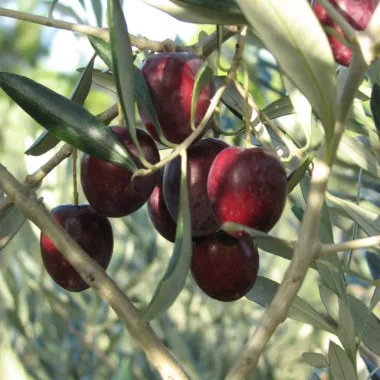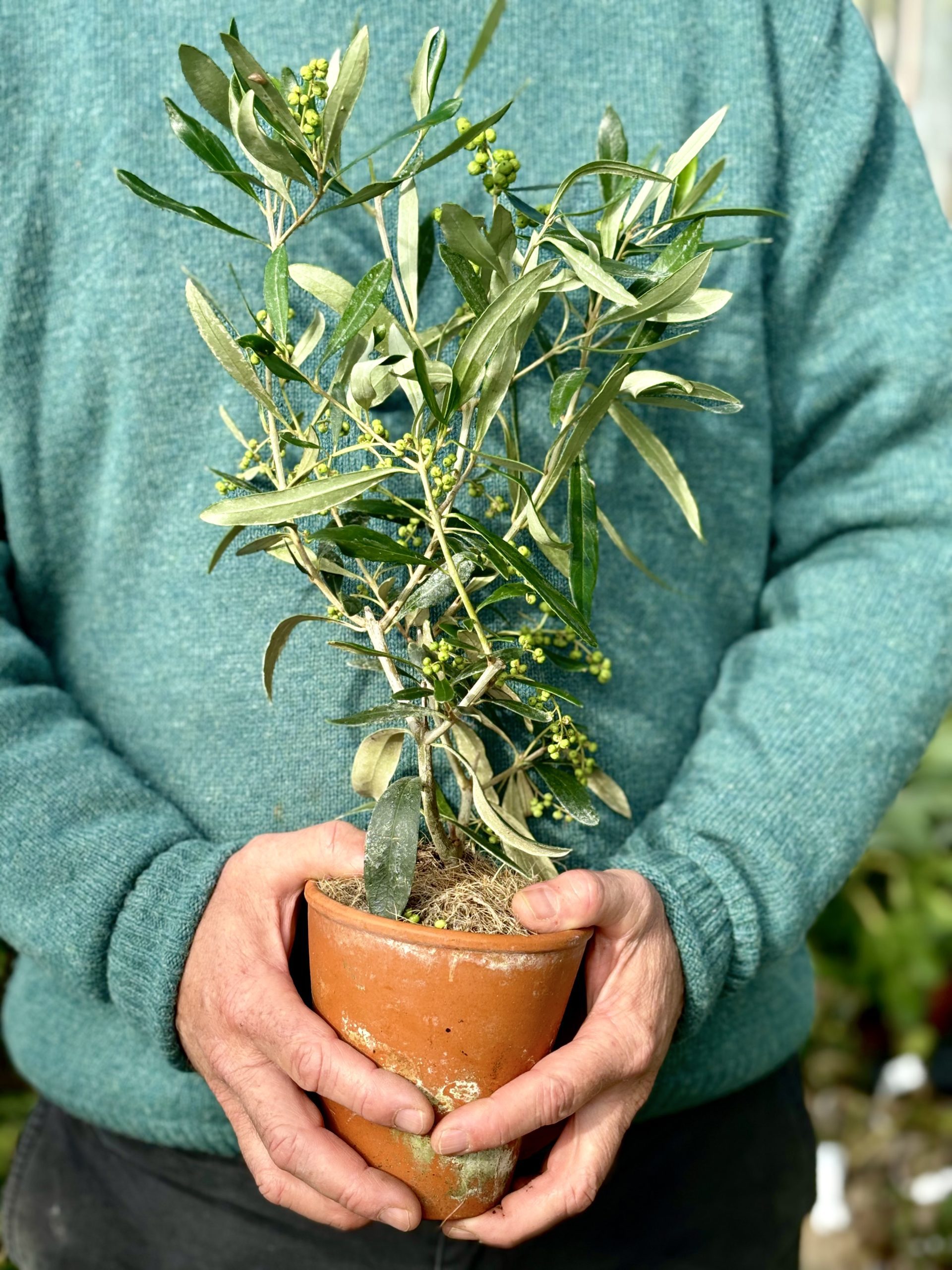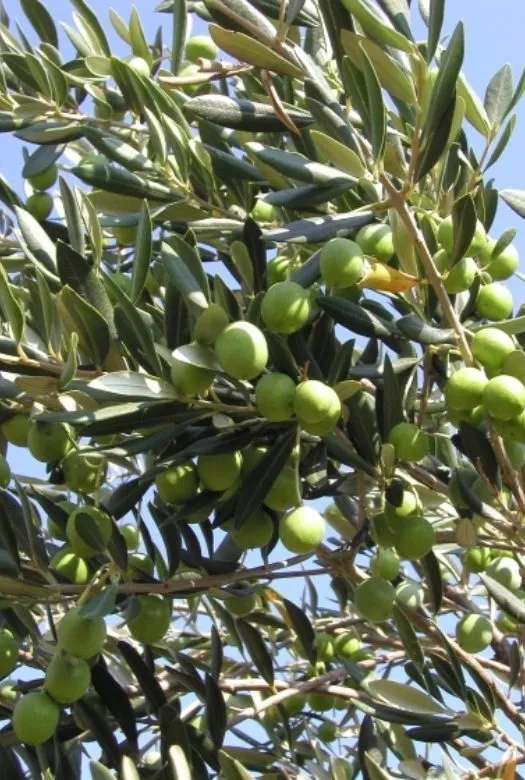Olive Tree
A Comprehensive Gluttonous Gardener Plant Care Guide
This essential evergreen has been cultivated in Mediterranean regions since at least 3000 B.C, both for its edible fruit and as a symbol of joy, happiness and peace.
It is among the oldest known cultivated trees in the world, being grown before the written language was invented. There are groves of olive trees planted by the ancient Greeks and Romans still producing fruit throughout the Mediterranean, and several thriving specimens believed to be at least 2-3,000 years old.
These beautiful trees are easy to care for and grow well even in poor or stony soils. Their silvery foliage will shimmer in the summer sun and brighten up the bare winter garden.
In a nutshell

Happy in a pot

Evergreen

Tree

Fruit
Care Instructions

Planting
Despite their Mediterranean origins, olive trees are tougher than you might think, but it’s wise to position your tree in the sunniest site possible, and select a well-drained, sheltered site. Olives planted close to a warm wall where they can bask in the sunshine will be the happiest. The olive tree is slow-growing and is therefore ideal for pot-growing; it will thrive in a large pot in a bright spot on the patio or balcony, or in an unheated conservatory or greenhouse. In cold or northern regions, winter protection in a conservatory, for example, will be required. Though olive trees are self-fertile, they are wind pollinated so should be kept outdoors whilst in flower if you’re hoping to grow fruit.
Olive trees may be planted at any time of year as long as the ground isn’t frozen. Dig a hole twice the size of the root-ball, spreading the roots as you refill the hole to the base of the stem. Press the soil down with the heel of a boot. For the first few seasons it’s wise to provide a stake for support whilst the plant establishes sturdy roots and a strong trunk.
When you need to re-pot your olive, choose a pot just a few inches larger. Ensure the pot has adequate drainage holes and put some gravel or crocks in the bottom. We recommend using a terracotta, rather than plastic, container and a sandy or loamy compost. Whether your olive is planted in the ground or in a pot it is essential to ensure maximum drainage. If you are growing your olive tree on heavy clay soil, you should dig in plenty of gravel to prevent the roots from becoming waterlogged.

Watering
Olive trees are known for being extremely drought tolerant and thriving in poor and stony soils, but it’s important to avoid allowing the soil to parch completely. Young olive trees with shallower root systems are most vulnerable to drying out, but more-established trees may also suffer in a particularly hot, dry summer. Trees allowed to dry out will become stressed, and flower and fruit growth will be inhibited.
Established trees should not require any watering throughout the winter, and younger or container-grown specimens should be watered less frequently throughout the cooler months.
Olive trees hate having soggy roots and a water-logged tree will show its displeasure by shedding leaves. A pot grown tree can easily become waterlogged so should stand on pot feet to allow water to drain away. It can also more rapidly parch in hot weather, especially when in a terracotta pot, so will require a more careful watering routine than a tree planted in the ground.

Feeding
An application of liquid fertiliser every month from early spring to mid-August will encourage healthy growth and a good crop of fruit. It’s best to feed lightly and often during the growing season. It’s wise to give your tree a feed such as blood, fish and bonemeal in early spring and a good mulch with well-rotted manure every other year will keep the tree happy.

Pruning
An olive tree won’t respond well to brutal pruning, and because they are so slow growing they don’t require too much effort with the secateurs but any dead or awkward branches can be removed in late spring, at which time you should also thin out densely gathered branches to allow light into the centre of the tree. Pinching out the tips of young shoots will encourage them to develop a branching shape.

Winter
Olive trees are hardy but may require some winter protection for the first few years. In heavy snow or particularly severe winter weather even established trees may be damaged but are easily protected with a wrap of hessian or fleece. Olive trees in pots can be moved to a more sheltered site or into a bright porch or greenhouse over winter, but remember that the tree will need a fluctuation between day and night time temperatures and a 2 month period of temperatures below 10°C to produce flowers and fruit.
Don’t be alarmed if your tree begins to drop leaves when spring arrives, olives naturally shed older foliage as the new season’s growth begins.

Harvest
Olive trees usually begin producing olives at about three to five years old. The olives will grow throughout the summer and autumn and ripen in mid-winter.
The olives may be picked when green, but are fully ripe when they turn black and begin to drop from the branches.

Preparing your olives
Immerse your olives in cold water, changing the water each day for ten days. This will remove the bitter taste of the raw olives.
Make a brine by heating water and stirring in salt. The best way to test your brine is by placing an uncooked egg in the pan as you’re adding the salt. Once the egg floats on the surface your brine is strong enough.
Put your olives into clean jars and pour your brine over. Store these jars in a cool place for 4 weeks before eating.
Our favourite way to eat home-cured olives is to drain away the brine and put them into a jar with orange zest, crushed bay leaves, crushed garlic cloves and generous glug of olive oil. Shake well and allow the flavours to develop for a few hours before eating. These will keep fresh in the refrigerator for two weeks.



